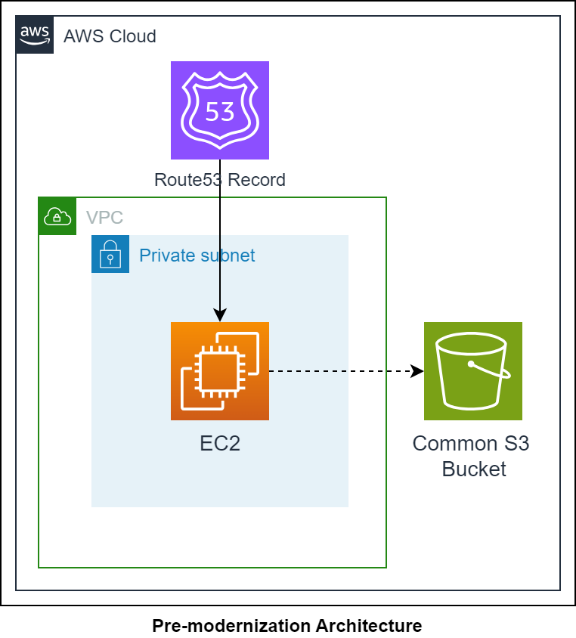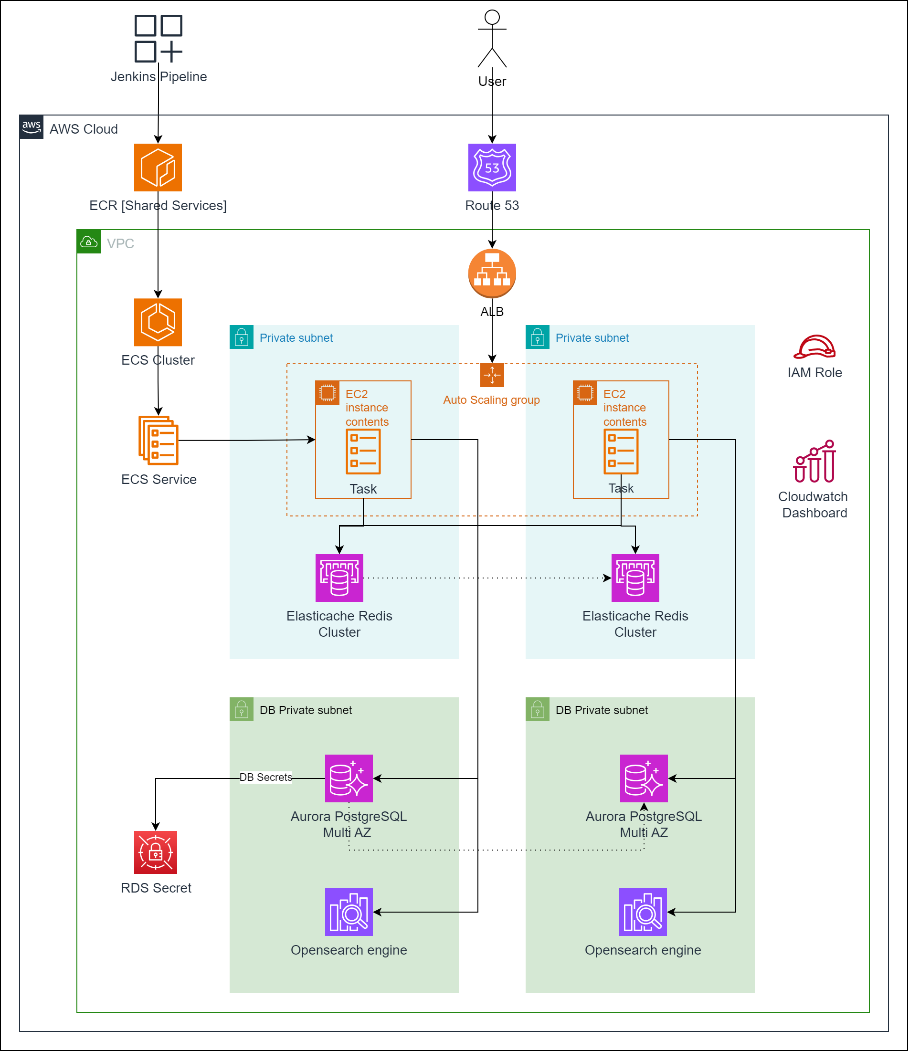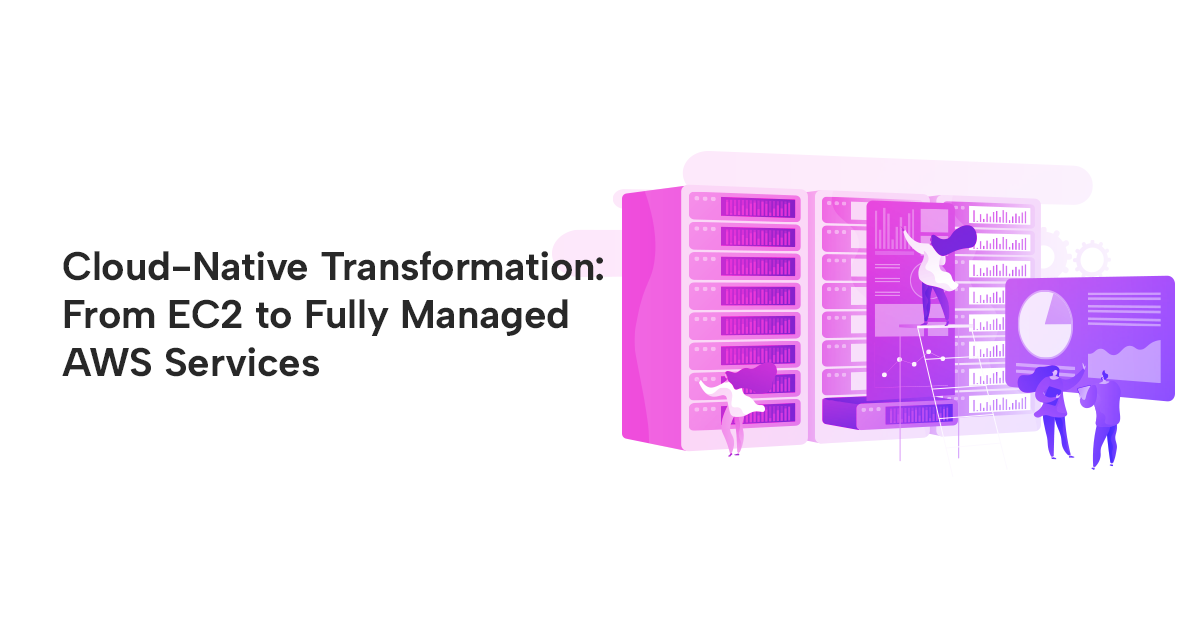Cloud-Native Transformation: From EC2 to Fully Managed AWS Services
By Sakshi Zalavadia, Piyush Jalan / Nov 06, 2024
As organizations scale, managing infrastructure on EC2 instances can become increasingly cumbersome. While EC2 provides flexibility, handling operations like hosting a web application, managing databases, caching, and search engine services manually can lead to inefficiencies. In our recent project, we encountered similar challenges while managing a growing application. To address these, we embarked on a journey of modernization, transitioning to fully managed AWS services such as Aurora PostgreSQL, ElastiCache, OpenSearch, and ECS, reducing operational overhead and enhancing scalability.
Existing Infrastructure (Before Modernization)
In the original setup, we relied heavily on EC2 instances for various services:
- EC2 Instances: Hosted the web application and managed the database, Redis cache, and OpenSearch engine.
- Single Point of Failure: The EC2 instances managing the database, caching, and OpenSearch presented a significant single point of failure. Any instance failure could lead to downtime and data unavailability.
- Manual Scaling and Maintenance: Each of these components required constant monitoring, manual scaling, patching, and updating.
- Operational Complexity: The team had to focus on backups, failover, and ensuring high availability manually.

This pre-modernization diagram illustrates how the EC2 instances were responsible for all major operations.
Challenges:
- High Operational Overhead: The team spent significant time on infrastructure maintenance, taking time away from feature development.
- Limited Scalability: Scaling required provisioning additional EC2 instances manually, leading to slow response times during traffic spikes
- Security and Compliance: Managing encryption, backups, and recovery procedures increased complexity.
Modernization Strategy
Our primary goal was to offload the infrastructure management tasks to AWS, allowing us to focus on improving the application itself. The key objectives were:
- Leverage Managed AWS Services: Migrate critical services such as databases, caching, and search to fully managed offerings, while moving the web application to ECS for better scalability.
- Remove Single Points of Failure: By leveraging AWS's managed services with built-in high availability and fault tolerance, we aimed to eliminate any single points of failure.
- Minimize Downtime: Ensure a smooth migration with little to no impact on the end users.
- Seamless Data Migration: Use AWS DataSync to migrate data from EFS and AWS Database Migration Service (DMS) for seamless database migration.
- Secrets Management: Securely store database credentials and sensitive information in AWS Secrets Manager, ensuring least-privilege access.
Modernized Infrastructure (After Modernization)
In the modernized setup, we transitioned from EC2-managed components to AWS-managed services. Here's a breakdown of the new architecture:

- ECS for Web Application: The web application is now hosted on Amazon Elastic Container Service (ECS), leveraging the scalability and ease of deployment of containers. This allowed us to scale the application more efficiently without managing the underlying EC2 instances.
- Aurora PostgreSQL: Migrated the database hosted on EC2 to Aurora, benefiting from automated backups, scalability, and better failover mechanisms. Aurora's performance and high availability reduce the need for manual database management.
- ElastiCache (Redis): Offloaded caching responsibilities to Amazon ElastiCache, which manages Redis clusters, ensuring high throughput and low latency while handling scaling automatically.
- OpenSearch: Migrated from a self-managed OpenSearch instance to AWS's fully managed OpenSearch service, improving indexing performance, reducing downtime, and offering integrated monitoring.
- Data Migration: We used AWS DataSync to seamlessly transfer data from EFS to the new environment, minimizing downtime. For database migration, AWS DMS helped us move the database with minimal disruption, ensuring data integrity and quick cutover.
- Secrets Management: Sensitive information such as database credentials was stored securely in AWS Secrets Manager. We followed the principle of least privilege access, ensuring that only authorized resources could retrieve the secrets.
Additionally, Route 53 is now responsible for domain resolution, while the use of CloudWatch ensures real-time monitoring of system metrics and performance.
Benefits of Modernization
By leveraging AWS-managed services, we observed several benefits:
- Scalability: ECS and services like Aurora PostgreSQL and ElastiCache support auto-scaling, allowing the infrastructure to handle traffic spikes without manual intervention.
- Eliminated Single Points of Failure: AWS-managed services inherently offer high availability, ensuring continuous operation even in the event of failures.
- Eliminated Single Points of Failure: AWS-managed services inherently offer high availability, ensuring continuous operation even in the event of failures.
- Improved Security: Built-in encryption, automated backups, and better role-based access control (IAM) improved the security posture of the infrastructure.
- Cost Efficiency: By moving to right-sized managed services, we optimized resource utilization, resulting in potential cost savings compared to over-provisioned EC2 instances.
Challenges & Lessons Learned
While the modernization process was successful, it wasn’t without challenges:
- Data Migration: Migrating large datasets to Aurora required careful planning to minimize downtime and avoid data loss.
- Service Integration: Integrating AWS services, especially configuring IAM roles, security groups and secrets for database connections, required careful attention.
Lessons Learned:
- Start Small: Migrating one component at a time allowed us to identify issues early and avoid major disruptions.
- Automate Where Possible: Using Terraform for infrastructure as code ensured consistency and reduced manual configuration errors. We leveraged custom modules to enhance code reusability, making the deployment process quicker and more efficient.
Conclusion
The shift from EC2-managed components to AWS-managed services has significantly reduced operational complexity while providing better scalability, security, and cost efficiency. By leveraging services like ECS for the web application, Aurora PostgreSQL for the database, and ElastiCache for Redis, we've eliminated single points of failure and built a highly available architecture. With AWS DataSync and DMS, data migration was seamless, and sensitive data is securely stored in Secrets Manager with strict access control. Moving forward, we plan to continue exploring more AWS services to further reduce operational burdens and enhance application performance.




